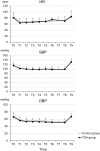Administration of tranexamic acid to patients undergoing surgery for adolescent idiopathic scoliosis evokes pain and increases the infusion rate of remifentanil during the surgery
- PMID: 28282425
- PMCID: PMC5345863
- DOI: 10.1371/journal.pone.0173622
Administration of tranexamic acid to patients undergoing surgery for adolescent idiopathic scoliosis evokes pain and increases the infusion rate of remifentanil during the surgery
Abstract
Background: We recently reported that tranexamic acid (TXA) evokes pain in rats by inhibiting γ-aminobutyric acid and glycine receptors on neurons in the spinal dorsal horn. Although TXA is commonly used to reduce perioperative blood loss during various surgeries, its potential to induce intraoperative nociception, thereby increasing the need for more analgesics during surgery, has not been investigated. Therefore, this study aimed to investigate whether TXA evokes pain and increases the need for a higher infusion rate of remifentanil in patients undergoing surgery for adolescent idiopathic scoliosis (AIS).
Methods: Data were collected from patients with AIS who underwent posterior spinal fusion surgery from January 2008 to December 2015. All surgical procedures were performed under total intravenous anesthesia with propofol and remifentanil, by the same team of orthopedic surgeons and anesthesiologists at a single institution. Patients in the TXA group were administered TXA (loading and maintenance doses, 1000 mg and 100 mg/h) whereas those in the control group were not. Our primary outcome was the infusion rate of the intraoperative opioid analgesic remifentanil.
Results: The final analysis was based on data collected from 33 and 30 patients in the control and TXA groups, respectively. No differences were observed in the demographic data or the hemodynamic parameters between the two groups of patients. In the TXA group, the durations of surgery and anesthesia were shorter, intravascular fluid volume and total blood loss were lower, and the doses of fentanyl and ketamine administered were higher than they were in the control group (P < 0.05 for all). The mean infusion rate of intraoperative remifentanil was significantly higher in the TXA group than in the control group (control group: 0.23 ± 0.04 μg/kg/min; TXA group: 0.28 ± 0.12 μg/kg/min; P = 0.014).
Conclusions: Patients who received TXA during the AIS surgery required a higher infusion rate of remifentanil, indicating that TXA evoked pain during the surgery.
Conflict of interest statement
Figures


Similar articles
-
Efficacy of tranexamic acid in reducing allogeneic blood products in adolescent idiopathic scoliosis surgery.BMC Musculoskelet Disord. 2016 Apr 27;17:187. doi: 10.1186/s12891-016-1006-y. BMC Musculoskelet Disord. 2016. PMID: 27117696 Free PMC article.
-
Preliminary investigation of high-dose tranexamic acid for controlling intraoperative blood loss in patients undergoing spine correction surgery.Spine J. 2015 Apr 1;15(4):647-54. doi: 10.1016/j.spinee.2014.11.023. Epub 2014 Nov 29. Spine J. 2015. PMID: 25457470 Clinical Trial.
-
Tranexamic acid diminishes intraoperative blood loss and transfusion in spinal fusions for duchenne muscular dystrophy scoliosis.Spine (Phila Pa 1976). 2007 Sep 15;32(20):2278-83. doi: 10.1097/BRS.0b013e31814cf139. Spine (Phila Pa 1976). 2007. PMID: 17873823
-
The efficacy and safety of combined administration of intravenous and topical tranexamic acid in primary total knee arthroplasty: a meta-analysis of randomized controlled trials.BMC Musculoskelet Disord. 2018 Sep 7;19(1):321. doi: 10.1186/s12891-018-2181-9. BMC Musculoskelet Disord. 2018. PMID: 30193586 Free PMC article. Review.
-
A comparison of combined intravenous and topical administration of tranexamic acid with intravenous tranexamic acid alone for blood loss reduction after total hip arthroplasty: A meta-analysis.Int J Surg. 2017 May;41:34-43. doi: 10.1016/j.ijsu.2017.03.031. Epub 2017 Mar 21. Int J Surg. 2017. PMID: 28336258 Review.
Cited by
-
Does spinal fusion to T2, T3, or T4 affects sagittal alignment of the cervical spine in Lenke 1 AIS patients: A retrospective study.Medicine (Baltimore). 2018 Feb;97(5):e9764. doi: 10.1097/MD.0000000000009764. Medicine (Baltimore). 2018. PMID: 29384864 Free PMC article.
-
The Influence of Anesthesia on Neuromonitoring During Scoliosis Surgery: A Systematic Review.NeuroSci. 2024 Dec 17;5(4):693-712. doi: 10.3390/neurosci5040049. NeuroSci. 2024. PMID: 39728681 Free PMC article. Review.
-
Tranexamic acid-induced focal convulsions after spinal surgery: a rare case report and literature review on side effects of accidental spinal administration of tranexamic acid.EFORT Open Rev. 2023 Jun 8;8(6):482-488. doi: 10.1530/EOR-23-0016. EFORT Open Rev. 2023. PMID: 37289050 Free PMC article. Review.
-
Accidental Intrathecal Tranexamic Acid Injection During Caesarean Section: A Case Report.Case Rep Anesthesiol. 2024 Oct 15;2024:4731010. doi: 10.1155/2024/4731010. eCollection 2024. Case Rep Anesthesiol. 2024. PMID: 39445087 Free PMC article.
-
Postoperative pain evaluation in laparoscopic radical prostatectomy surgery using tranexamic acid: analgesia?, hyperalgesia??World J Urol. 2025 May 13;43(1):300. doi: 10.1007/s00345-025-05581-w. World J Urol. 2025. PMID: 40358732 Free PMC article.
References
-
- Andersson L, Nilsoon IM, Colleen S, Granstrand B, Melander B. Role of urokinase and tissue activator in sustaining bleeding and the management thereof with EACA and AMCA. Ann N Y Acad Sci. 1968;146:642–58. - PubMed
-
- Dunn CJ, Goa KL. Tranexamic acid: a review of its use in surgery and other indications. Drugs. 1999;57:1005–32. - PubMed
-
- Hoylaerts M, Lijnen HR, Collen D. Studies on the mechanism of the antifibrinolytic action of tranexamic acid. Biochim Biophys Acta. 1981;673:75–85. - PubMed
-
- Iwamoto M. Plasminogen-plasmin system IX. Specific binding of tranexamic acid to plasmin. Thromb Diath Haemorrh. 1975;33:573–85. - PubMed
-
- Thorsen S. Differences in the binding to fibrin of native plasminogen and plasminogen modified by proteolytic degradation. Influence of omega-aminocarboxylic acids. Biochim Biophys Acta. 1975;393:55–65. - PubMed
Publication types
MeSH terms
Substances
LinkOut - more resources
Full Text Sources
Other Literature Sources
Medical

